Designing Pool and Jacuzzi
Nowadays, swimming pools and jacuzzis are built with modern or classic designs to raise the comfort level and well-being in residential buildings, villas, hotels, etc. In the following, the method of design and construction, cost estimation, equipment and supplies needed, etc., for the construction of swimming pools and jacuzzis have been examined.
Designing Pool and Jacuzzi Expert Guide and Price
A swimming pool is an artificial structure that holds water needed for different purposes. In general, pools are divided into different groups in terms of usage, the type of materials used in pool construction, and the location of the pool concerning the ground.
Swimming pool construction
Pool construction steps:
As you know, the construction of a swimming pool includes design, calculation, implementation, construction, and installation stages, which are very important to perform correctly, accurately, and in principle, and require relevant experience and knowledge, which in brief are the most important titles and stages The description is as follows:
- Preparation of a pool map based on the client's request (3D and 2D map)
- Determining the geographical location for the construction of a swimming pool and water treatment plant
- Conducting tests on the soil and obtaining soil endurance parameters for pool construction
- Installation calculations include:
- Determining the type and size of pipes and fittings according to environmental weather and soil conditions
- Flow diagram and block diagram of all stages of the installation
- Determining the place of draining and cleaning the related filters (swimming pool or jacuzzi)
Construction calculations include:
- Rebar sizing
- Type and degree of durability of concrete
- Mesh size (steel mesh)
- How to use rebars (to reduce the amount of deviation)
Implementation of facilities (mechanical and electrical) taking into account the environmental conditions (in cases where the pool is open, appropriate and standard depth in terms of anti-freezing), insulation (cold and heat) Implementation of reinforcement operations according to the calculations and formwork and concreting of the construction of the pool (with appropriate concrete vibration) Insulation inside the pool, the so-called pool sealing, and 48-hour sealing test (it should be noted that things like Izogam or Qirguni should never be used to seal the pool.) Performing pool ceramic work (after at least a 48-hour pool sealing test) Implementation of the treatment plant and installation of all pre-designed pool equipment Installing internal pool projectors (pool lights) and sealing them Design, construction, and installation of the central switchboard, to command all the stages of purification, draining, and digging in order to build a swimming pool
For advice and pool construction, be in touch with the experts of Damatajhiz HVAC Group.
Pools are divided into several categories in terms of usage, such as:
- Private pools: In general, private pools are smaller than public pools. Private or home pools are usually built in dimensions of 9.6 x 4.8 meters to 6 x 12 meters, while the length of public pools is usually not less than 25 meters. Private pools can be built in two types: permanent or temporary. Temporary pools can be collected in the winter season and placed again in the summer season.
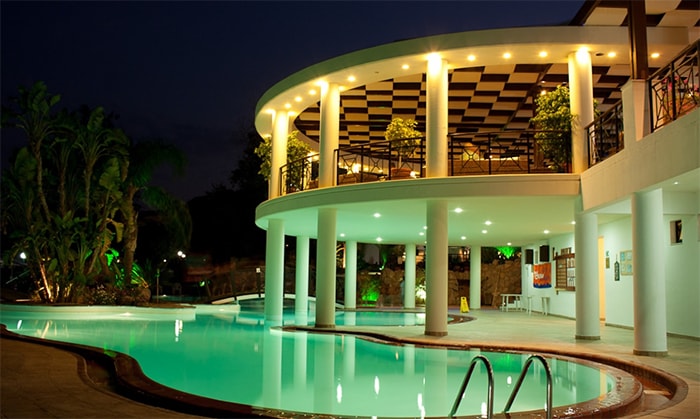
- Public swimming pools: Public swimming pools are often a subset of sports centers in which different parts such as hot water pools, indoor pools, military pools, children's pools, etc. are considered. Outdoor pools are usually used in tropical regions. A diving platform is usually considered when constructing large and deep pools. Of course, diving platforms should only be installed in the construction of pools with sufficient depth, so that diving does not create danger for them.
- Championship pools: The characteristics of championship pools used in international competitions are determined by the swimming federation. According to the standards of this federation, the length of championship pools should be 50 m or 25 m and their minimum depth should be 1.35 m. In order to be able to hold competitions throughout the year, championship pools are usually built indoors and the area inside the pool is equipped with a suitable heating system.
- Therapeutic pools: Taking advantage of the therapeutic properties of water has been of interest to mankind for many years so its history goes back to about four thousand years before Christ. Hydrotherapy is the use of ice, steam, or hot or cold water and its purpose is to improve physical condition, eliminate physical discomfort, and improve body function.
Therapeutic pools can be placed in the following groups:
- Spa pools (they are divided into two groups of whirlpool pools and air pools)
- Cold water ponds
- Natural hot water pools
The types of pools in terms of structure are:
- Concrete pools
- Pools sealed with vinyl
- Fiberglass pools
- Metal pools
- Wooden pools
Concrete pools:
Among the different types of pools, concrete pools have the most flexibility in terms of design, size, and shape. So that the shape and design of the pool can be implemented with reinforcement in the appropriate area. The first step for the implementation and construction of a concrete pool is the preparation of engineering plans. Excavation, reinforcement, and construction of the pool of the next stage, which is done according to the engineering plans. Steel rebars are used to reinforce concrete pools. Standard concrete molds are usually made of wood, fiberglass, or steel. In fact, it is the type of molding that determines the appearance of the concrete surface after removing the molds. After finishing the reinforcement, concrete pouring is done. After curing the concrete, the time varies according to the climatic conditions of the region and the thickness of the concrete layer, and the surface is formed using different methods and materials.
- Concrete pool construction methods:
- Using reinforced concrete under pressure to ensure that the walls and floor of the pool will remain permanently under pressure. Of course, this method can also be used for the passages around the pool bowl and the floor of wet areas, which of course depends on the design of the pool.
- The use of reinforced concrete in the form of a sandwich causes a strong increase in the dead load of the structure.
- Using reinforced concrete with PVC2 coatings, similar coatings, or decorative waterproof coatings by spraying
- Construction of swimming pools with sprayed concrete:
- The American Concrete Association defines sprayed concrete as mortar or concrete that is sprayed pneumatically and at high speed on surfaces. In England, they sometimes use the term (gunite) instead of sprayed concrete. The advantages of sprayed concrete can be summarized as follows:
- With this method, there will be no need to use concrete molds that have a high cost.
- The pool can be built in any desired shape without imposing a staggering cost on the project.
- With this method, the speed of pool construction can be increased. By using sprayed concrete, the pool can be used in crowded sites where access to materials and equipment is associated with many limitations. The advantage of this method is that for pouring concrete between reinforcements, using a concrete sprayer equipped with a hose pipe, it is possible to pour concrete up to a distance of at least 100 m.
Pool colors and finishes:
In cases where it is not possible to use tiles or mosaics due to budget constraints, suitable colors or coatings produced for this purpose can be used in the construction of the pool. Using paint is the cheapest way to cover the surface of the pool bowl. Of course, this cheapness comes at the price of reducing the useful life of the surface of the pool, because paints have the shortest lifespan among other coatings. In areas where the level of underground water is high, it is not recommended to use paint as the surface of the pool bowl in the construction of the pool because these pools must be completely drained and repainted every few years.
The most important features that should be considered when choosing a swimming pool cover are:
- The coating used should have enough beauty in terms of color and appearance.
- This coating should have a smooth and impenetrable surface and be easy to clean.
- This coating should be able to protect the bottom layer.
- Since in many pools, the bottom layer is made of cement or concrete, this coating should not leave an adverse effect on their properties and status.
- This cover should be elastic enough, because the shell of the pool moves slightly during filling and emptying, with the change of water temperature or the small movement of the structure.
The main types of colors and coatings used in the construction of swimming pools can be summarized in the following cases
- Chlorine-containing polymer paints:
The use of these types of colors is very common for both indoor and outdoor pools. These colors usually consist of chlorinated polymer, softening materials, neutral pigments, and a thickening or gel-like agent. One of the disadvantages of these types of colors is that their manufacturers usually recommend that the color remain within a certain temperature and humidity range, which is a little out of reach in outdoor pools. - Acrylic, epoxy, and polyurethane coatings:
These colors are usually produced in the standard range and bring a favorable result. Epoxy and polyurethane resins strongly adhere to concrete, coated surfaces, and floor coverings. - Cement-based paints
Pools in terms of location
Pools are divided into the following two groups according to the ground level:
- Ground level pools
- Above ground pools
Damatajhiz HVAC; The best prices and brands of construction equipment
Locating the Swimming pool
Covered pools(indoor) and private pools each have their advantages and disadvantages. It should be noted that indoor or outdoor swimming pools will have the greatest impact on the architectural and structural condition of the building.
With the popularity of indoor swimming pools in recent years, so that it is possible to use the pool in all seasons of the year, employers have been more inclined to build indoor swimming pools. The first advantage of indoor pools is that they can be used all year round. The operation period of open-air swimming pools during the year is usually not more than one hundred and fifty days. In an outdoor pool, there will be problems such as freezing of water, soiling of the pool floor and wall due to external factors, water color change due to falling leaves and gum from trees into the pool, and similar problems. Of course, indoor swimming pools are also associated with problems.
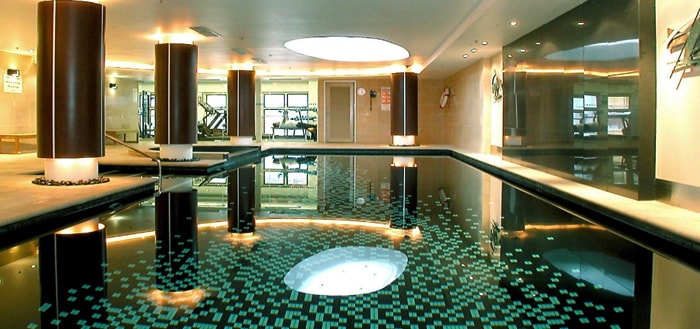
Indoor pools
In indoor swimming pools, just like the closed spaces inside the building, for the swimmers to feel comfortable and at ease, the conditions inside the swimming pool must be in favorable condition in terms of temperature, relative humidity, indoor air quality, lighting, and other factors like that.
The most important considerations that should be considered in the design and construction of indoor swimming pools can be summarized in the following:
- Controlling the air inside the pool in terms of temperature and relative humidity using different methods such as ventilation, dehumidification (with a dehumidifier) , and heating of the pool air.
- Providing the required lighting in the space inside the pool
- Providing the necessary structural requirements to prevent pool water leakage to other parts of the building
One of the most important problems faced by designers in the construction of indoor swimming pools is providing thermal comfort to swimmers. In addition to ensuring the comfort of swimmers, controlling the air inside the pool also helps to increase the useful life of the building and its equipment. The warm and humid environment of indoor swimming pools provides suitable conditions for the growth of fungi and bacteria. At the same time, the entry of polluted and humid air that carries pathogenic bacteria endangers the health of swimmers. Most of the lighting needed by indoor swimming pools during the day can be provided by using natural light. In recent years, with the increase in the cost of energy consumption, the attention of many designers has been directed to the maximum use of sunlight to illuminate the building during the day. Of course, one of the most important arrangements for lighting indoor pools is to consider emergency lighting for sudden power outages, especially at night and when a person is using the pool alone in an indoor pool without a window to provide lighting.
The use of large windows in the construction of swimming pools, all-glass facades, ceiling skylights, and the like, in addition to reducing energy consumption by reducing the need for lighting facilities, is psychologically beneficial for swimmers and pool staff who work all day in a closed environment. It is desirable.
One of the mentioned problems is the glare of sunlight due to its reflection by shiny surfaces, wet components inside the complex, and water surfaces. The easiest way to reduce light glare is to remove the path of light reflection from the field of view of people inside the hall. If the reflected light is not placed in the field of vision of people, a major part of its glare will also disappear. Despite the problems that the use of natural light in the pool hall brings, it is not possible to clear the face of the problem by issuing a general ruling and encouraging everyone not to use this method. But in the case of using this method, all the mentioned considerations should be taken into consideration. In fact, this method puts the main burden on the shoulders of the architectural team in the design and construction of the pool, which with its creativity provided a method for the indirect use of this light in the design and construction of the pool.
The degree of protection is abbreviated as IP3. The degree of protection of electrical equipment such as electric motors, lamps, sockets, electric heaters, etc. is defined based on the IEC commission standard. According to the European EN standard, the degree of protection of all lighting facilities used in the design and construction of swimming pools must comply with EN60598 standards. As a general recommendation, it is not recommended to use false ceilings for the design and construction of indoor swimming pools. This work means creating an unventilated area in the pool, where the possibility of problems such as water distillation and corrosion is very high. Therefore, if a false ceiling is implemented in the design and construction of the pool, this part must be ventilated just like the space inside the pool.
Ceiling lights, with all the advantages they have for providing lighting inside the pool during the day, are not considered a suitable option from the point of view of air conditioning. Because the surface of these reflectors, especially in cold regions, is soon exposed to distilled water vapor. Also, the large amount of exhaust air required to prevent distillation on these reflectors is often considered one of the challenges of channel network design.
Outdoor pools:
- Choosing the location of outdoor pools is usually associated with certain limitations.
- Most of the time, the general plan of the pool should be presented based on the plan of the main building, which is usually a sports complex. Of course, sometimes private swimming pools are built inside gardens or courtyards of buildings, the conditions of which are slightly different from public pools.
- The considerations that must be followed when determining the location of outdoor pools can be summarized as follows:
- The position of the pool should be chosen in such a way that the pool bowl and its surroundings have the most light, especially in the afternoon and evening.
- To maximize the heat of sunlight, the pool bowl should have the most light absorption from the south and west sides.
- Before determining the location of the pool, sufficient tests should be done on the characteristics of the soil in the area. Because the characteristics of the soil will have a significant impact on the cost of building the pool and its implementation.
- As much as possible, you should avoid building a pool in the vicinity of tall trees or saplings that will turn into big trees in the future. Because with the growth of these trees, their roots also grow and penetrate more into the soil, and if the pool structure is located near them, the possibility of damage to the pool foundation, drainage lines, and plumbing system increases.
- Considering obstacles such as a large fence, a garden wall or a part of the main building that blocks the passage of airflow is an advantage for outdoor pools. So by reducing the airflow on the male pool bowl, the evaporation of water and its heat loss will be reduced to a great extent. Meanwhile, swimmers who get out of the water with a wet body are less exposed to the airflow and enjoy the pool environment more.
- Determining the route of discharge, water line, electricity branches, and gas pipeline should be done with the maximum possible accuracy.
- For public pools, the design of the pool and its side space should be done in such a way that the locker room of the complex is located as close as possible to the pool bowl.
- The required sanitary services and electricity distribution should also be provided for the outdoor swimming pools. This point is sometimes completely ignored during the construction of private pools.
- Therefore, after determining whether the pool is covered or not, the most important point is its location and the design of the environment around the pool bowl based on the determined level line.
- The recommended minimum size for the length and width of the pools is 6 m and 4 m, respectively, with a minimum depth of 1 m.
- As a rule of thumb to provide comfortable conditions for people inside the pool, the area of the pool bowl should be at least 4.5 square meters per person based on the number of people who are going to swim in it at the same time.
After determining the type and dimensions of the pool, the most important factors that should be considered in the construction of swimming pools are:
- The stability of the structure
- The durability of the structure
- The structure resistance against water penetration
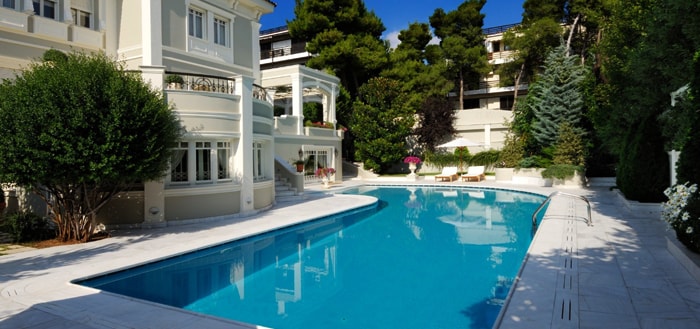
The shape and dimensions of the pools:
- Based on older standards, public pools were built in a rectangular or L shape.
- In L-shaped pools, the shorter length can be assigned to the shallow part and the longer length to the deep part of the pool.
- Classic public swimming pools are usually 25 meters long, and standard swimming competition pools are usually 50 meters long with six to eight swimming lanes.
- Nowadays, swimming pools are mostly used as an environment for recreation and relaxation, and this recreation is more influenced by the space around the pool and its side facilities than by people swimming in the water.
- Some public swimming pools use facilities such as artificial wave generation equipment, water slides, dry sauna, steam sauna, jacuzzi, fitness club, buffet, lighting and even playing music in the pool hall.
Therapeutic pools:
- Treatment pools are due to special use, except in rare cases, all treatment pools are built indoors.
- Treatment pools are usually designed and built in dimensions of 5x10 meters and with a depth between 1.50-0.90 meters. The floor of these pools should be made with a completely uniform and gentle slope. Note that the purpose of sloping these pools is simply to facilitate the draining of the pool water.
- The floor of these pools and all the wet areas of the treatment pools should be covered with non-slip ceramics and tiles or mosaics.
- If the level of the pool is not the same as the level of the floor, shiny ceramic channels should be used to improve the water circulation at the exit of each skimmer.
- The pool water replacement period should not be more than three hours. The facilities of some therapeutic pools are also designed based on the water replacement period of one and a half hours.
- The temperature of the pool water and the air temperature of the pool hall and locker room should be higher than the normal temperature of swimming pools. So in many therapeutic pools, the water temperature is considered between 29-33 degrees Celsius and the air temperature of the hall is approximately 27-29 degrees Celsius.
- Since the users of therapeutic pools are usually weak, disabled, or elderly people, the necessary arrangements should be made for the passage of these people from the changing room to the pool and their easy exit from the water.
Jacuzzis
- The first and most important similarity between swimming pools and jacuzzis is that both of them are designed and built to hold water for a relatively long period of time. Currently, many of the small jacuzzis are sold in the form of integrated and prefabricated units, which has made the work much easier.
- Emergency key:
In general, jacuzzis should be equipped with a local switch to cut off the electric current, which can turn off the electric motor in case of emergency (such as people's long hair being pulled with great intensity towards the drain valve). The emergency power cut-off switch should be located at a distance of 1.5 m (5ft) from the jacuzzi and it should be accessible to users. - Power outlets:
For all hot tubs that are installed outside the building, at least one 125 V, A15, or A20 electrical outlet related to the general branching circuit must be considered at a distance of 1.5-3 m from the inner wall of the hot tub. - Lighting facilities:
The standards and regulations that must be considered for the installation of permanent lighting facilities for jacuzzis. It is exactly the same as what was said about permanent lighting installations in swimming pools. In addition to these facilities, standard lighting facilities with two branches can be used in temporary pools. - Grounding and connecting components:
All electrical equipment that is located at a distance of 1.5 meters from the inner wall of the jacuzzi, must be connected to the ground and connected with all electrical equipment related to the water circulation system. All the metal components in the hot tub that are located at a distance of 1.5 meters from the inner wall of the hot tub must be connected to each other by direct metal-to-metal connection or by using a connecting bridge in the form of AWG8 copper wire.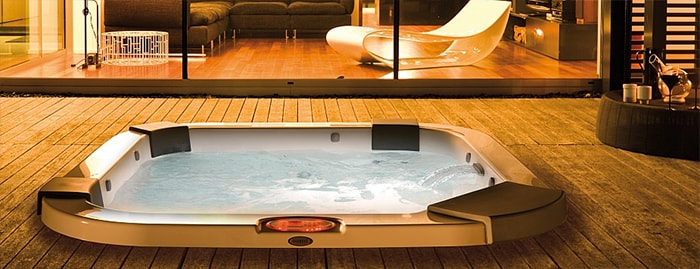
- Dear user:
- While thanking you for your trust in the technical opinions of heating equipment sales experts, it should be noted that the determination and selection of the desired product brand for the design and construction of swimming pools and hot tubs based on history, brand strength, services, and the price is ultimately determined by the buyer.
- If, after reading the above material, you have more questions about deciding on the design and construction of a swimming pool and jacuzzi, you can get advice from the sales experts of the swimming pool, sauna, and jacuzzi equipment department after contacting the Damatajhiz HVAC collection and extension numbers 103-105-106. And ask your questions.
"Buy with confidence and peace of mind"

Trademark registration certificate - Stewardship business license from the Virtual Business Association - Business license from the heating and air conditioning equipment industry
The presence of Damatajhiz HVAC Group in international exhibitions of construction facilities and cooling and heating systems
See more, choose better
Dear user: If you make an online purchase of swimming pool, sauna, and jacuzzi products from the Damatajhiz HVAC reference site, you will have the possibility of delivery within 4 to 6 working hours in Tehran (and 2 working days for cities).
In addition to a valid business license from the Heating and Air Conditioning Trade Association, the Damatajhiz HVAC Group has an electronic trust symbol and started its store site in 2013 at the head office in Tehran.
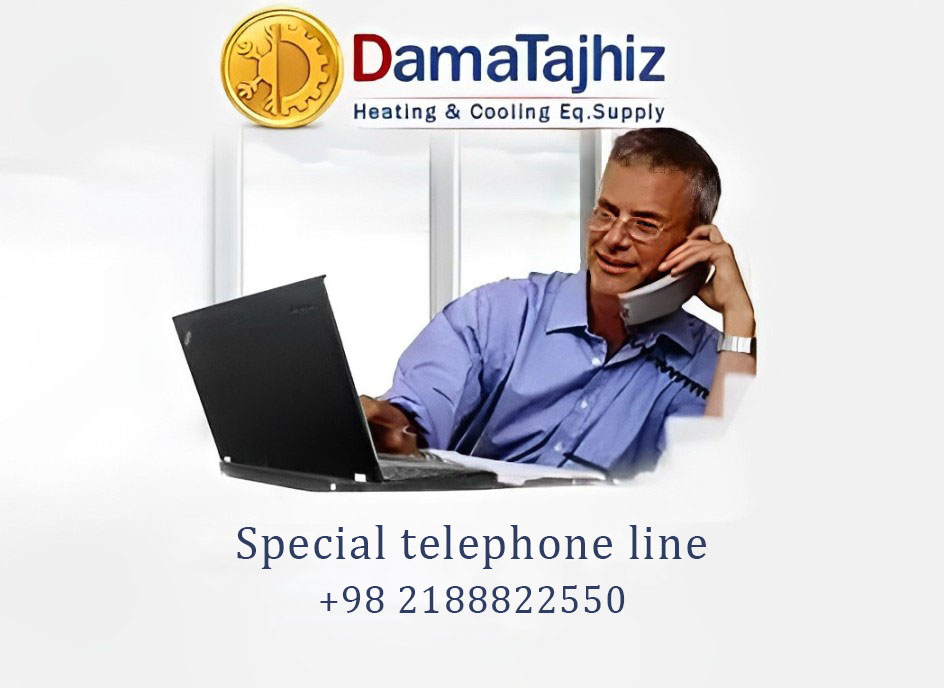
We are waiting for your call and look forward to meeting you in the specialized collection of equipment
By sharing the above texts on social networks, inform your friends about its important content.
| |
Head Office: No. 463,Talebian Alley,Taleghani St.Tehran,Iran


DamaTajhiz has provided the opportunity to sell and ship specialized HVAC equipment for applicants in the following countries as the first and the most popular online store for selling HVAC equipment (Heating , Ventilation , Cooling , Air conditioning) in the Middle East : Afghanistan – Tajikistan - Uzbekistan – Turkmenistan – Azerbaijan – Armenia – Georgia – Turkey – Iraq – Syria – Jordan – Kuwait – Emirates – Qatar – Oman.